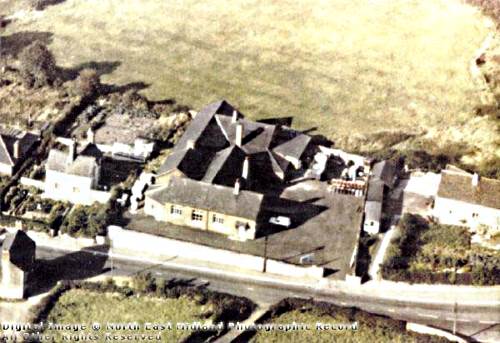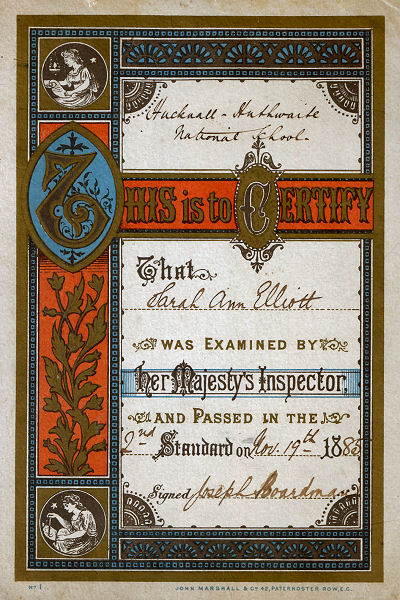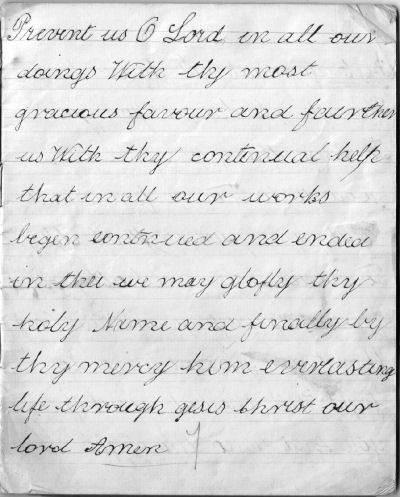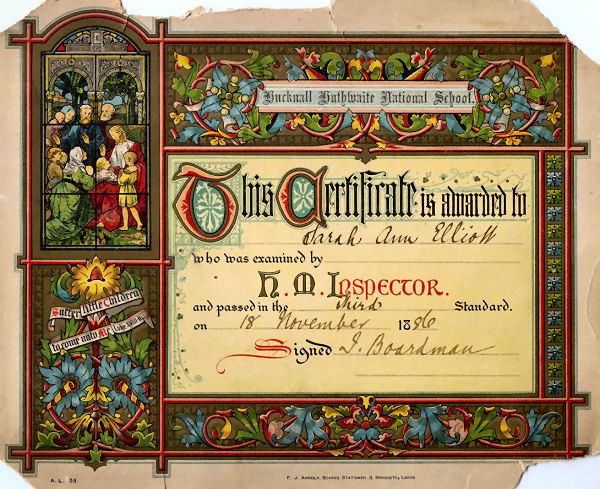A Hucknall History
Historic Schools
National / Church / Blackwell Road
The vicar of Sutton took credit initiating a schoolhouse to accommodate all Hucknall Huthwaite children in full time education. With a vested interest, it would be aptly licensed for dual purpose of performing services before a local village church could be merited.
LAYING THE FOUNDATION STONE AT HUCKNALL.
The township of Hucknall-under-Huthwaite, which, although separate for all civil purposes, is ecclesiastically a portion of Sutton parish, has for many years been very much neglected. The exertions of the members of the Wesleyan churches there have provided the only means of education which have existed as well as supplied the only means of public worship nearer than Sutton itself. The consequences has naturally been that a very great amount of ignorance has prevailed amongst the younger portion of the population, which has been far from satisfactory to those of the inhabitants whose better knowledge and increasing intelligence has shown the necessity of early instruction. The commencement of active exertions to remedy this, dates, so far as we are aware, from the introduction of the Rev. C. Bellaire as incumbent of this parish, and through his labours, seconded by those of his indefatigable assistants, the Rev. J. Martin and the Rev. W. Bellairs, the present movement towards a better state of things has been brought about. The Countess Dowager of Carnarvon, whose residence near us at Teversal Manor House has already been productive of much good, on having the state of the village represented to her, with a rare generosity at once offered to give a site for the schools and £100 towards the cost of execution. Mr. Rawson, a gentleman well known to all in Hucknall, added to this the sum of £50, and contributions from other friends have raised the fund to nearly £540.
This sum is however, insufficient to complete all that is necessary, and we trust that further contributions will shortly enable the work to be fully carried out. The schools, as designed, will accommodate 300 children, and there will be two rooms and a class room of the respective dimensions of 35 feet by 22 feet, 32 feet by 20 feet, and 22 feet by 12 feet, in the largest of which evening services, in connection with Sutton church, will be held every Sabbath. There will also be two teachers' residences. Monday last, the 2nd inst., was the day appointed for the laying of the foundation stone, and so through a gala day Hucknall probably never before saw. The endeavors of an active local committee to make the village in trim for the occasion were highly successful and the decorations reflect great credit on those who designed and carried them out. Triumphal arches of evergreens, adorned with flowers and surmounted by mottoes appropriate to the occasion, spanned the streets, and the people, in holiday attire, thronged the footpaths. About two o'clock three hundred children of the Wesleyan Methodist and Reform Sunday schools met on the green, and, proceeded by the committee and headed by the Hucknall brass band, marched along the road towards Sutton.
They were accompanied by their teachers and bore flags and banners of every size and device, which heightened in no small measure the gay appearance of the procession. They shortly met the children of the Sutton National schools, headed by the drum and fife band, and the whole party returned to the place for the ceremony. The site for the schools is situate down the hill, on the opposite side of the road to Mr. Robinson's house, and a little way below it. Here all preparations had been made for the ceremony. The stone, which had been presented by S. Fisher and Son, stone merchants, of Mansfield, was placed ready, and Mr. S. Hibbert's men, of Sutton, were in attendance. C. J. Neale, Esq., of High Oakham, from whose designs the school will be built, superintended the proceedings. In the hollow of the stone was placed a glass jar, containing a copy of the "Midland Gazette," a stocking (of local manufacture), an order of the service, a florin, shilling, sixpence, silver 4d., ditto 3d., a penny, halfpenny, and farthing. The opening was made secure by an iron plate bearing the following inscription: "The coins beneath deposited by Henrietta, Countess of Carnarvon, donor of the site, and principal contributor to the funds of this building, September 2, 1867."- Punctually to the time appointed the Countess arrived, accompanied by her son, the Hon. Auberon E. W. Herbert, (fellow of St. John's college, Oxford), the Lady Gwendoleen Herbert, and Miss Dawkins.
They were received with much enthusiasm. Amongst the visitors we noticed the Hon. and Rev. J. V. Vernon of Nuttall; Mrs. Wood of Swanwick Hall, with, whom were Miss Marshall, Mrs. Young, and Rev. John Wood; the Rev. F. G. Morgan of Teversal, with Mrs. and Misses Morgan; the Rev. T. Woodman of Kirkby; the Rev. A. Brook of Mansfield Woodhouse; the Rev. W. Benson; the Rev. R. H. and Mrs. Frazell of Normanton; Sir Edward and Lady Walker of Berry Hill; Mrs. Seely of Brookhill Hall; the Rev. C. Martin; the Rev. Charles and F. Walford Bellairs; and other clergymen and gentlemen of the neighbourhood. The ladies were well represented and their gay toilettes under the hot rays of a summer sun added not a little to the spectacle. The ceremony was commenced by the choir chanting the 69th Psalm, after which the Rev. J. Martin repeated a most appropriate prayer. A verse of a hymn having been sung, the Countess and her son advanced to the stone, where she was presented by Mr. Neale with a handsome silver trowel, (manufactured at Lambert's, silversmith to her Majesty, Coventry-street,) which bore the following inscription: "Henrietta, Countess of Carnarvon. Presented by 300 inhabitants of Hucknall, on the laying of the first stone of the Schools and School chapel. September 2, 1867." Mr. Neale said, "I have the pleasure of presenting to your ladyship this trowel, purchased by 300 of the inhabitants of Hucknall as a token of their respectful gratitude."
To this the Countess replied, "I accept it with the greatest possible pleasure, I will keep it, and it will be preserved by my children after me." The stone was then laid with all due form, levelled, adjusted, and pronounced "truly laid," after which the Countess repeated in a distinct voice the following words: "In the faith of Jesus Christ we place this headstone in the foundations in the name of the Father, the Son, and the Holy Ghost; that here true faith, the fear of God, and brotherly love may dwell; and that this place may be set apart for the instruction of the young, and for the honour of the name of our Lord Jesus Christ." The remainder of the very appropriate service which had been prepared for the occasion was then gone through by the officiating ministers, the Revs. C. and W. Bellairs and the Rev. C. Martin, in a very impressive manner. This part of the ceremony being ended, the Rev. C. BELLAIRS said : Ladies and gentleman,- Before we leave this spot which has been made so interesting to us by the ceremony which has just been performed, I desire, as the clergyman of this parish, to say a few but earnest words. First, I desire to congratulate the people of Hucknall on the prospect which now lies before them of having a school, and a place of worship for themselves and their children. (Hear, hear.)
It is true that when I came to Sutton a few months ago I laid before my mind's eye the hope that, if God spared my life and health for a time, as minister of this parish, I should see a school and possibly a church in this district. The prospect then lay before me in the far distance as the result of long and patient exertion, but by the kindness of friends, some of whom are assembled here to-day, the prospect of five months ago appears an immediate prospect, and, if God spares me a few months longer,
I sincerely trust that the building which has been begun to-0day will be finished, and in full operation. Cheers.) I desire now to mention the names of four persons - and four only - as persons who have laid upon us an obligation which, I think, we shall never be able to discharge; and first of all in this list I would couple together two friends of my own - Mr. Talbot and Mr. Martin. (Hear, hear.) These gentlemen are both tutors at Oxford, and have both received from that university the highest academical honors which it is able to bestow upon its scholars. Most persons situated as they are consider themselves at liberty during the vacation to amuse themselves and spend their holidays in recreation, but Mr. Martin, instead of going abroad or spending his time in amusements, has thought it better to come amongst the people of Sutton, and work gratuitously among you for the long vacation, and he leaves behind him to-day a lasting memorial of his kindness and his exertions, for he may be said, in one sense, to be the inaugurator and originator of these schools. (Applause.)
In the second place I desire to mention the name of Mr. Rawson, a gentleman whom we should have been extremely glad to have welcomed among us to-day. (Hear, hear.) He has long felt a great interest in the spiritual affairs of Hucknall, and has only been waiting for an opportunity like the present to display that interest by making a handsome donation towards this structure. (Cheers.) Last of all - though not least or last in heartiness or sincerity - I desire to add that the thanks of my fellow parishioners, and my most sincere and cordial thanks are due to that noble lady, who together with a gift of land and money, has added the graceful act of coming amongst us to-day to lay the foundations stone. (Applause.) It has pleased God Almighty to place Lady Carnarvon in a high social position; it has pleased God that she should spring from a family which stands nearest the throne in dignity; it has pleased God to endow her with wealth and influence; but I believe that He has given to her gifts much higher than any of these, for he has given her an understanding heart and a disposition to use these blessings for the glory of God, and for the benefit of her fellow-creatures. (Cheers.)
I can only hope, in conclusion, that God my be pleased to spare Lady Carnarvon's life, not only to see these schools built and in full operation, but to see the children who are around us to-day, grown up to be men and women, and that her ladyship may find them a well-conducted, well-behaved people, loyal and obedient to their sovereign, and the laws of their country, but above all obedient subjects of that blessed Saviour in whose faith, and relying in whose merits, we have laid the foundation-stone of these schools. (Loud Cheers.)
Lady CARNARVON then said: I must say a few more words, and return thanks to the 300 inhabitants of Hucknall who have given me this delightful token to-day. I shall never forget this occasion, and the trowel will always be valued by me, and this day be had in most pleasing remembrance. The ceremony having thus terminated, the Hon. AUBERON HERBERT said: Ladies and gentlemen, I am sure that I can answer with the greatest confidence for the feelings under which my mother (the Countess) is present amongst you to-day. It would be impossible, I think, for anyone to see the pains which have been taken, to see the interest which you all show in the proceedings, and not to have the greatest possible satisfaction and pleasure in sharing in any way, however, humble, however shall, in the great and good work of which the foundation-stone has been laid to-day. I do not think that I am saying to much when I say that the happiness of the whole country seems to me to depend upon the great movement of schools being carried on; upon every village and upon ever hamlet having its school, and to see them scattered broad-cast throughout the land. And those who take any pleasure in visiting different parts of England, I think, will agree with me in feeling that wherever you go to any parish or village and find there a well-to-do and well ordered, comfortable looking school, you will always find that village shows other signs of comfort and progress; that i looks as if all its inhabitants were good and useful citizens, that they live in self-respect, that they honour and obey the laws of their country.
But that wherever you go to any district, where the eye looks in vain for schools, where if you do find one it seems to be of little use, but little respected and cared for by the inhabitants, that the social progress of the rest of that district corresponds with the state of the school. I recollect being very much touched indeed when I was in America with seeing the way in which, wherever the forest land was cleared and a few wooden huts had been erected, how the settlers in those wild domains always set themselves as their first duty to build a rough church and a rough school. (Hear, hear.) If the prosperity of that country has depended on one thing I think it has depended on this: that they have always made it their first point wherever they went and carried their civilisation to build schools. (Hear, hear.) I was struck very much the other day in reading the words of an eloquent writer - a writer who has pleaded many great causes. He said, "If people would but understand what was the most important thing - what was the most important manufacture, if I may use such a word, in a country, and could carry it out that land would at once take its place before all other countries.
Do not point me, he said, to your populous cities, and tell me that here there is much wealth gathered together; however stately may be the buildings or palaces, I look to what is more important still - I ask who are those who throng the streets, what are they? Are they merely money seekers, pleasure seekers? And, on the other hand, to a crowd broken in spirit and given up wholly to toil and going on in ignorance. If this is so, I can find no satisfaction in such a sight; but if a city be devoted to trying to train all those who belong to it and they may be useful citizens, training and education them from earliest childhood, then, indeed, that city, that town, that country, or district, has a right to be called great, and to occupy the first place."
I hope I have not kept you too long; I have spoken strongly about what I think you all feel strongly, namely, that the one great duty which lies before us at the present day is in every was to lend our help in trying to do what we can to improve, raise, and educate all those in the midst of whom we live; and to recollect this, that in the case of schools, if we neglect to place a school where there should be one, evil goes on accumulating as precious years are allowed to pass, until we have to pay the penalty of our neglect, and the loss, the evil, which result can never be cured, are past all remedy, lie hopelessly beyond all exertions, when those have grown up to be men and women whom we should have care for in youth. After returning hearty thanks for the kind reception given to the Countess, the speaker concluded, and three cheers were then enthusiastically accorded to Lady Carnarvon.
The flag preceding the choir bore the Molyneux Arms, viz., "A Golden Cross Molines." The land forming part of the old Molyneux Estate, the last member of which family bequeathed the estate to Lady Carnarvon - his great niece.
The children and their friends, numbering over 600, subsequently had tea in spacious marquees at the lower end of the field. The evening was spent in dancing, racing for prizes, &c., her ladyship having given a number of fire-balloons, sugar plums, etc., for the children. The whole proceedings passed off with the greatest success, and the sum of £13 was received at the gate.
A widowed Countess of Carnarvon extended her husbands previous generosity promoting many good causes, by giving land upon Hopkin Lane, along with £460 towards building costs. January 13th 1868 dates enrolment, when Mary Ann Forrester became the first of 90 names registered that day. For a total cost around £800, the Hucknall Huthwaite National School was thus duly opened.
Including a master residence first filled by John Joseph Sharpe,  classrooms could accommodate up to 440 pupils. Mistress Mrs Ann Sharpe took separate charge of girls, while Miss Mary Parker taught all the mixed infants.
classrooms could accommodate up to 440 pupils. Mistress Mrs Ann Sharpe took separate charge of girls, while Miss Mary Parker taught all the mixed infants.
The ages of those who initially enrolled varied from 3¾ to 15½ years old. Three large classrooms were deemed sufficient, simply dividing mixed infants from teaching all boys and all girls. Typical age range for pupils would be set from 5 to 10 year old, after an 1880 Education Act finally made school attendance compulsory for that agreed age group. Despite that, there was no stopping poorer children being commonly put to work outside school hours.
National Schools aimed to teach first and foremost the Church of England Religion. Strong Christian beliefs did play bigger part in this buildings design as detailed by another chapter. Brief mention must recognise the Sutton Rev C Bellairs performed Sunday afternoon services here, and progressive use afforded Huthwaite its own curate. In 1874 an apse was built at the west end wing, dedicated by the Bishop of Lincoln, holding its first Confirmation Service. This all gives reason for not only unexpectedly finding early references towards a Church School, but also a Church Street that renamed Hopkin Lane a short period. Modern addressing thereafter identified location for this past Blackwell Road School.



Year 1881 finds this masters residence has been filled by Joseph Boardman. He may be recognised from a 1915 class photo, when comparing scene from descendant J Lubbe. That year dates shown transfer onward to be Head at Burton Latimer Church School where his voluntary war efforts plus title "Champion of the Poor" was well recognised with an honorary caricature.


Fabulous original mementos of Hucknall Huthwaite National School from pupil Sarah Ann Elliott, were kept by granddaughter Mrs Betty Cornwell.


Mr Boardman had been assisted at the Hucknall Huthwaite National School by teachers Miss Mary Key and Miss Annie Grundy in charge of girls and infants. While they retained their Blackwell Road classrooms, the 1891 opening of a second National Church School on Common Road, is inferred by 1900 to be initially designed for separately relocating the boys classroom under his tuition.
Seeing a 1907 parish church erected opposite roadside, the Church of England appointed a vicar after asserting separate parish status for a renamed Huthwaite. Mr Herbert A Simpson is next identified Headmaster over these National Church Schools. Needhams 1913 directory lends some conflicting confusion between dated understandings and titled photo evidence, while assuring the Common Road school had then swapped role to begin solely classing infants under mistress Miss Mary Cook.
Blackwell Road School
An annual Blackwell Road School Christmas treat is able to confirm 1933 teaching staff members were lastly named; Messrs C Bonsall (Headmaster), WG Thomas, G Walker, E Gunby, Mrs S Gascoigne, Misses Whetton, Belshaw and Lineker.  They must have witnessed that years final closure, which unfortunately passed by without finding actual photos of the long stood premises. There are nevertheless several class year shots before c1928 scene best exposes background schools.
They must have witnessed that years final closure, which unfortunately passed by without finding actual photos of the long stood premises. There are nevertheless several class year shots before c1928 scene best exposes background schools.
The Blackwell Road Schoolhouse had further accommodated various other uses over the years. Chapel roomed annual vestry meetings. Monthly Local Board officials met here until electing a Hucknall Huthwaite Urban District Council. Hosting lectures notably included Huthwaite's first mining training classes to best qualify those who inevitably sought employment among the many locally neighbouring coal pits.
Along with expensive maintenance costs, the Blackwell Road Schools were handed over to the Nottinghamshire. Education Committee on November 1st, 1929. Teaching continued enthusiastically, although a third Council School then took majority of pupils. Adding jumble sale events, while an associated football and cricket ground was well used beyond scholar team friendly matches, the Huthwaite Parish Vicar remained custodian of the disused property beyond its 1933 closure by the Board of Education. Rev WL Boulton managed to utilise two old class rooms to initiate a lads club December 1935. Residents thought the premises ought to have been reopened in previous year when finding need for extra local classrooms, but the outdated design only appears to have lastly served purpose in the war effort by accommodating WWII trainee soldiers.
Demolition must have followed, maybe a decade or so after, to open up a substantial plot suiting new industrial use. Mebon Paints established a specialised factory, adopted by and through other company names since. Comparing a 2005 Ameron International with the presently adopted Spencer Coatings Ltd shows original front stone wall is lasting remnant from years when many folk like my grandfather Charles Elliott finished their education to most usually start colliery work at his acceptable working age then of 14.


21 May 12 by Gary Elliott Updated 21 Apr 19
